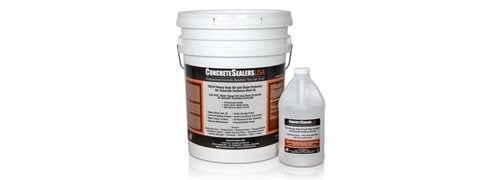- Concrete Sealer
- Comparison Chart of Concrete Sealers
- Buying Tips for Concrete Sealer Products
- Concrete Sealer Reviews: Sealer products other contractors use and recommend
- Common Questions about Concrete Sealers
- How to Remove Concrete Sealer
- Types of Sealers
- Acrylic Sealers
- Epoxy Sealers
- Penetrating Sealers
- Polyurethane Sealers
- Polyaspartic Sealers
- Application Surface
- Driveway Sealer
- Patio Sealer
- Pool Deck Sealer
- Sealers for Stamped Concrete
- Concrete Floor Sealers
- Concrete Countertop Sealers
- Pool Deck Sealer
- Exposed Aggregate Sealer
Types of Concrete Sealers
Use this comparison chart of concrete sealer types to determine which is best for your projectPicking the right sealer will make a difference in both appearance and performance. Compare the different types of concrete sealers in the chart below and determine which one is best for your project.
| Sealer Type | How They Work | Primary Uses | Type of Finish | Performance |
|---|---|---|---|---|
PENETRATING SEALERS(includes silanes, siloxanes, silicates, and siliconates) |
Penetrate and react chemically within the capillaries of the concrete to shield against moisture penetration and deicing chemicals. | Exterior concrete surfaces subject to corrosion and freeze-thaw damage. Where a natural, matte finish is desired. | Provide invisible protection without changing the surface appearance or leaving a sheen. | Provide excellent protection against outdoor exposure conditions. Most products are also breathable, allowing moisture vapor to escape. |
ACRYLICS |
Form a thin protective film on the concrete surface. Available in both solvent- and water-based formulations. | Both exterior and interior concrete. On projects where easy application and economy is important. To enhance the beauty of colored, stamped or exposed-aggregate concrete. On fast-track projects, since acrylics often dry to the touch within an hour. | Available in a range of sheen levels. Solvent-based acrylics generally enhance color better than water-based products. | Provide good protection against water and chloride intrusion, but usually wear faster than polyurethanes and epoxies. Solvent-based acrylics generally perform better than water-based products for outdoor use. On indoor surfaces, softer acrylic sealers usually require regular maintenance with several coats of a sacrificial floor finish, or wax, to prevent wear and black heel marks. |
POLYURETHANES |
Form a high-build protective film on the concrete surface. Available in both solvent- and water-based formulations. | Both exterior and interior concrete. On floors in high-traffic areas, to provide good resistance to scuffs and staining. To enhance the beauty of colored, stamped or exposed-aggregate concrete. Concrete countertops. | Available in a range of sheen levels. Finish is transparent and non-yellowing. | Nearly twice as thick as acrylic sealers, and produce a very durable chemical- and abrasion-resistant finish. Most urethanes are moisture intolerant until they cure, so no water should be present on the surface when the sealer is applied. |
EPOXIES |
Form a high-build protective film on the concrete surface. Most are two-component products mixed prior to application. | On floors in high-traffic areas. Cement-based overlays. Concrete countertops. May yellow with UV exposure, so generally limited to interior use. | Available clear or pigmented, if you wish to add color. Most products impart a glossy finish. | Produce a hard, long-wearing, abrasion-resistant finish. Also offer excellent water repellence, but some products are impermeable and could trap moisture in the concrete. |
*Note: Always check with the sealer manufacturer to verify the compatibility of its product with the decorative surface you plan to apply it to.
Matte concrete sealer vs wet look concrete sealer
Matte concrete sealers don't impart any sheen on the surface, while wet look concrete sealers have a glossy finish. Wet look concrete sealers are usually film-forming and may require a grit additive for better traction.
Shop for Concrete Sealers
 D-One Penetrating Sealer
Non-yellowing, low sheen, good adhesion
D-One Penetrating Sealer
Non-yellowing, low sheen, good adhesion
 Deep Penetrating Sealer
RadonSeal - Waterproofs & strengthens.
Deep Penetrating Sealer
RadonSeal - Waterproofs & strengthens.
 Clear-Seal by Increte Systems
Seals and protects decorative surfaces.
Clear-Seal by Increte Systems
Seals and protects decorative surfaces.
 Heavy Duty Oil & Stain Protector
TS210 - 4 gal. kit ($439.95)
Heavy Duty Oil & Stain Protector
TS210 - 4 gal. kit ($439.95)
 Colored Concrete Sealer X-4
High gloss finish available in 20 colors
Colored Concrete Sealer X-4
High gloss finish available in 20 colors
 Gem-Guard SB
Penetrating sealer that protects against salt damage
Gem-Guard SB
Penetrating sealer that protects against salt damage
 Decorative Sealers
Reactive and penetrating formulas in various levels of gloss.
Decorative Sealers
Reactive and penetrating formulas in various levels of gloss.
 Water Repellent Penetrating
Sealer for driveways, parking structures, plazas, walkways & more.
Water Repellent Penetrating
Sealer for driveways, parking structures, plazas, walkways & more.
 Clear Acrylic Concrete Sealer
$219.30 (5 gal.)
Clear Acrylic Concrete Sealer
$219.30 (5 gal.)




